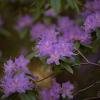December 13, 2010 - 5:44am
In the midst of a light snowfall on a chilly afternoon, Doug Gow and Kate Parsons work toward bachelor degrees in Natural Resource Protection by monitoring the health of a picturesque urban creek.
The third-year students at Vancouver Island University are taking water samples and measuring the flow of Departure Creek for their Environmental Monitoring course taught by Dr. Eric Demers.
“This project has been a great way to get some practical experience in our field, and any time spent at the stream is a welcome change from the classroom,” says Gow.
VIU’s Resource Management Officer Technology (RMOT) 306 course requires students to conduct field projects and evaluate the environmental quality of various local watersheds.
Projects are selected with consultation and/or financial support from community stakeholders such as Fisheries and Oceans Canada, Living Rivers - Georgia Basin and Vancouver Island, City of Nanaimo, Regional District of Nanaimo and the Nanaimo and Area Land Trust (NALT). The Departure Creek Restoration and Enhancement Project is also being supported by the Departure Bay Neighbourhood Association and the Pacific Salmon Foundation.
“The community engagement aspect of these projects greatly enhances the student experience by providing broader relevance to course work,” says Demers.
NALT has a 15-year history of land protection and stewardship and Executive Director Gail Adrienne says the organization values the contribution of the students who are monitoring water quality on Departure Creek.
“The data they collect will complement and inform the monitoring work done by volunteer Departure Creek Streamkeepers now and in the years ahead,” says Adrienne.
VIU graduate Kasia Biegun (BA Psychology 2009) has played a valuable role this fall as project assistant for the Departure Creek restoration initiative, Adrienne says. Biegun helped co-ordinate a recent community information evening, a watershed awareness day in late September on World Rivers’ Day and a Streamkeepers Workshop to train community volunteers who will act as stewards for the waterway.
Biegun also organized a program called School of Fish, that engaged local schools in the creek through guided walks, storm-drain marking and planting trees in the riparian areas along the creek. When Biegun leaves NALT at the end of December, a new Departure Creek Streamkeepers Group will carry on with community outreach and habitat restoration work.
Departure Creek has recorded resident populations of cutthroat trout and sea-run coho salmon in the past but fish habitat has been damaged by urban encroachment. The creek flows through private property and Woodstream Park as it winds down to Departure Bay near the intersection of Bay Street and Departure Bay Road. It has suffered from waste runoff and a barrier installed to control sediment blocked pink salmon from swimming upstream to spawn.
The barrier was removed last summer and replaced with more natural measures to control the flow of the creek. NALT and the community have been working with other conservation groups and the city to further improve the fish habitat by planting vegetation along the waterway and raising awareness about the impact of storm runoff on the health of the creek.
In the meantime, Gow and Parsons are analyzing samples and measurements from field trips in November and earlier this fall. The data can be used to measure changes in the conditions of the waterway.
Both Gow, who has had summer employment with Manitoba Conservation, and Parsons, who has worked for Metro Vancouver Park, expect to use the experience as they pursue careers in environmental management.
For more information:
Resource Management Officer Technology programs at VIU: viu.ca/rmot/
Nanaimo and Area Land Trust: nalt.bc.ca/
Living Rivers - Georgia Basin and Vancouver Island: livingrivers.ca/gbvi/index.html
Tags: In the Community






